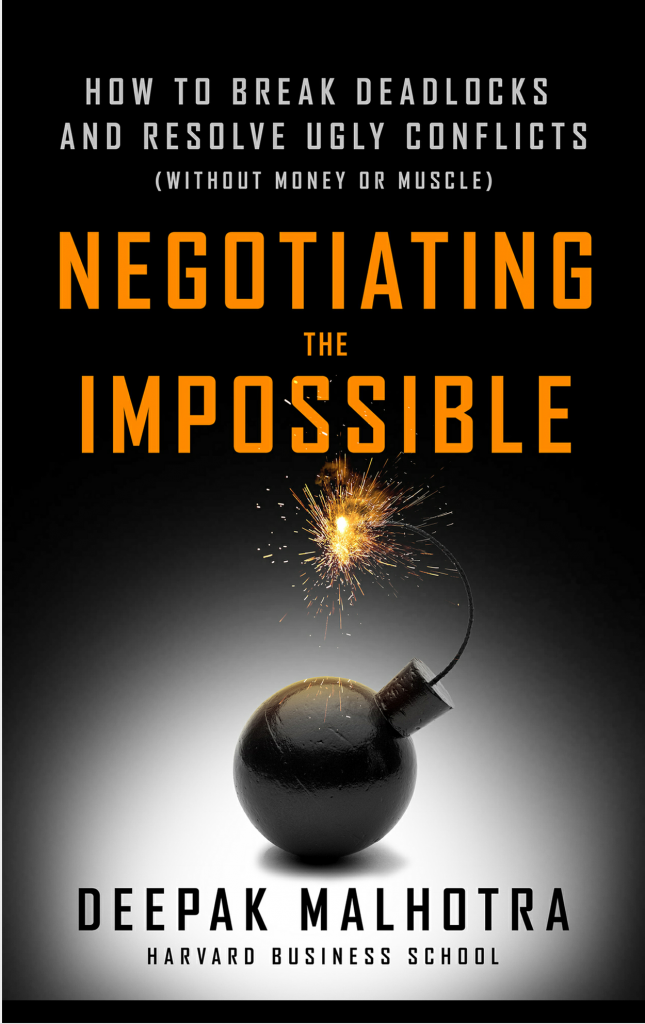I was recently introduced to “Negotiating the Impossible: How to Break Deadlocks and Resolve Ugly Conflicts (Without Money or Muscle)” by Deepak Malhotra. Professor Malhotra is the Eli Goldston Professor of Business Administration at Harvard Business School. While it is not about lawyers in civil legal disputes or mediated settlement conferences the book nevertheless teaches some important lessons for our negotiations.
This article will cover a high level overview of the book but there is so much valuable information in the book that I will leave details to future posts. Hopefully, an overview will whet your appetite. Professor Malhotra describes three “tools” or “levers” for effective negotiation: the power of framing, the power of process, and the power of empathy. Before describing these levers, a more general understanding of the book’s theme can be derived from its subtitle.
One of the most important insights is stated succinctly in its introduction: “Even seemingly impossible deadlocks and conflicts can be resolved if we shed the assumption that our only sources of leverage are money and muscle.” As any experienced litigator knows, some negotiations are won because one party has more power in terms of the financial wherewithal to finance litigation and/or absorb the effects of an adverse judgment. The examples Professor Malhotra uses illustrate how to use other levers to effect a negotiation and perhaps overcome the power of money and muscle.
The power, or lever, of framing is based on the premise that how you structure and articulate your proposal may be as important as the substance of the proposal. I would go one step further and add that the timing of a proposal can often be just as important. A good offer at the wrong time is not a good offer.
The frame of the negotiation is the lens through which the parties view the conflict. It influences how the other party is perceived, how the issues are perceived, and what outcomes are possible. For some time, I have been studying and applying the principles of narrative mediation to my practice. The principles of narrative mediation are based upon a similar premise: People in conflict view that conflict as part of a story or narrative. Narrative mediation attempts to open the parties in conflict to a narrative that is at the least less adversarial. Framing the negotiation is not quite the same thing, as we will see, but shares the idea that changing the perception of a dispute opens the possibility of resolution.
To illustrate the power of framing, Professor Malhotra cites the NFL’s Collective Bargaining negotiations in 2011. The owners and players were negotiating what percentage of revenues the players would receive. The negotiations deadlocked as both sides became more and more entrenched. The deadlock was broken when the revenues were separated into different streams and percentages were negotiated for each. By conducting separate negotiations, both sides were able to declare victory to their constituents. As Maholtra puts it: “Objectively identical proposals can be made more or less attractive simply by how they are presented.
The power of process is the idea that the negotiation over process may play a decisive role in determining outcomes on the substantive issues. Although this is not always possible in negotiating a civil dispute, Professor Malhotra introduces this lever by describing the work of James Madison as architect of the U.S. Constitution. As most know, the Constitutional Convention was not called to create a new constitution. It was called to debate amendments to the Articles of Confederation, a seriously flawed system of government.
Madison’s “genius” as Professor Malhotra calls it was the recognition that Articles were so flawed that they needed to be scrapped, not amended. Prior to the commencement of the Convention, Madison began drafting a series of resolutions that, although presented as amendments, eviscerated the Articles. The entire debate shifted from changes to the Articles to support or opposition to the various elements of the “Virginia” plan as it came to be known.
In a subsequent article, the use of this lever will be explored in more depth. It is important to note that reshaping the process as used here is not about the actual process of mediation — e.g., one-day vs. multiple sessions or having or not having a general session. It is about shaping the debate.
The final lever is the power of empathy. Perhaps the most important — and difficult — task of a mediator is to help the parties see the struggle from the other side. Empathy creates more options for resolution. Maholtra points out that empathy in this context is not something you do to be nice and should not be considered a sign of weakness. It is about understanding the conflict from the other perspective. Very few people see themselves as the villain of the story. Understanding why the other side believes they are justified in their position creates an opportunity to understand the underlying interests and expand the possible settlement options.
The book is a fabulous collection of real world examples of negotiators using these levers to resolve what appear to be impossible situations. Over the coming months, this blog will explore these concepts in more detail and attempt to translate Professor Malhotra’s examples to illustrate how the powers of framing, process, and empathy can used in the resolution of civil litigation.

